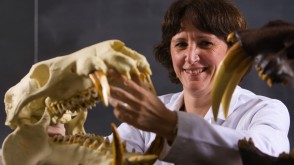Witness to Evolution

In her corner office on the second floor of Carr Hall, Dr. Gina Semprebon, professor of biology and director of the Center for Excellence for Women in STEM (CEWS), has had the unusual privilege of being a witness to evolution.
An internationally recognized paleoecologist, Dr. Gina Semprebon studies prehistoric life forms (think dinosaurs!) and their interactions with their environments. In brief, Gina has pioneered a scientific method that examines microscopic scars on the dental enamel of mammals caused by food substances. The results allow Gina and others to reconstruct the interactions between ancient ecosystems and the changing or evolving dietary habits and habitats of mammals. It provides scientists, climate change ecologists, and all young and old lovers of extinct animals a window into the past when giants and creatures who continue to thrill our imaginations walked the earth.
For over 30 years, Gina has pursued her career at Bay Path and has been witness to another remarkable evolution: the transformation of the University at the Longmeadow campus and beyond. In fact, she has been part of it.
“I first met President Leary when she was walking on campus to be interviewed. I did not know her, but she came up to me and introduced herself and called me by name. I asked her, ‘My goodness, how do you know my name?’ She replied that she was familiarizing herself with Bay Path by looking at the yearbooks. She noticed the past year’s edition was dedicated to Professor Gina Semprebon, and recognized me by my photograph. I was so impressed! I said to myself, ‘This is an extraordinary person. Her memory is incredible and she remembers names.’ Although I wasn’t on the search committee, I believed she would be good for Bay Path.”
Gina was, however, on the first Vision Plan team of President Leary’s tenure. It was around 1996, and this blueprint would set the tone and direction of what would come for the next 25 years: bold and courageous actions and ideas that would redefine Bay Path. In Gina’s words, “I could see in Carol Leary that she could get us where we needed to be. She wasn’t afraid.”
It wasn’t long before Gina herself had a new vision for the sciences at Bay Path.
“In the beginning, I was teaching primarily in our Occupational Therapy associate’s program. We had no bachelor’s degrees with majors in the sciences. By 2002 our enrollment was growing, and I learned from many of our students that they wanted to pursue careers in medicine, veterinary medicine, or the sciences. It was a significant shift that really coincided with the marketplace. We were just on the edge of STEM careers for women taking off. I went to the Provost Bill Sipple, and he gave me the green light to develop and launch majors in biology, biotechnology, and forensics. In time, I became the chair of the science department.”
Soon, the sheer number of science students, fueled in part by the popularity of forensic science, started to exceed the physical space of Carr Hall. The University was faced with either renovating Carr Hall or building a new facility.
“I traveled in a van with President Leary and Provost Sipple to visit other science facilities at colleges in New England. We wanted to know what was out there in terms of pioneering laboratories, and how we could build to the future. In the end, we decided to renovate Carr Hall.”
As a result, Carr features five state-of-the-art laboratories, redesigned cutting edge classrooms and study spaces, and, most important, equipment that can support the growing emphasis on research and interactive learning within the programs. The next step was to create other pathways to attract and retain science students to Bay Path.
“Our current Provost, Dr. Melissa Morriss-Olson, met with me and asked if I wanted to create a Center for Excellence for Women in STEM. Today, we call it CEWS. It was a good opportunity for me to take all the things I know and have done, and establish a program that was also inclusive of women in the greater scientific community.”
It was just a matter of time that the WiSH (Women in STEM Honors Program) and the Stern Scholars (named in honor of major donor Eileen Stern) joined the CEWS as one of the myriad of offerings for science students. Concurrently, Bay Path received three major NSF grants beginning in 2013.
“The impact of the NSF grants cannot be understated. They were pivotal to our growth in the sciences. The grants helped us to attract women, particularly underrepresented groups, to STEM fields, provided scholarship assistance to students, and was instrumental in revising our curriculum for active learning and research. CEWS initiatives were greatly enhanced by the NSF funding.”
Today, there are over 180 students enrolled in the undergraduate science program. Students are graduating and enrolling in medical or veterinary schools, doctoral programs, and pursuing careers in a range of science-related professions. Dr. Gina Semprebon has been a significant force in this academic evolution, mirroring the changes at the University. Indeed, her role and impact, like so many who have contributed to the transformation of Bay Path, have been revolutionary.
Dr. Gina Semprebon received her doctorate in biology from the University of Massachusetts Amherst. She holds master’s degrees in education and biology from American International College and the University of Massachusetts Amherst, respectively.
